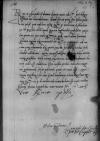Letter #3537
Łukasz GÓRKA to Ioannes DANTISCUSPoznań (Posen), 1532-08-10
Manuscript sources:
Auxiliary sources:
Prints:
| ||||||||
Text & apparatus & commentaryPlain textText & commentaryText & apparatus
Reverendissimo in Christo Patri et Domino, domino
Reverendissime in Christo Pater et Domine, domine maior colendissime. Post diligentissimam mei commendationem.
Haud scio, an quisquam sine scelere praeterire potest, quin reditum Vestrae Reverendissimae Paternitatis incolumem et illustrem ex tot praeclare obitis apud
Datum
Vestrae Reverendissimae Paternitatis ad mandata


 BCz, 1595, p. 424
BCz, 1595, p. 424